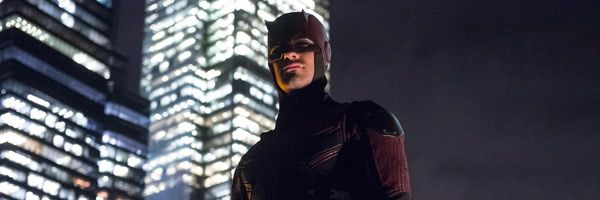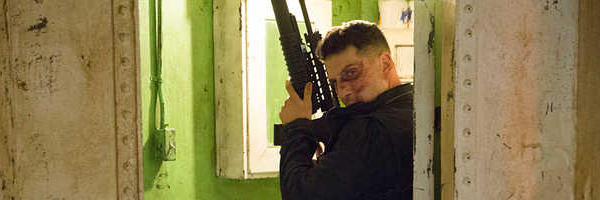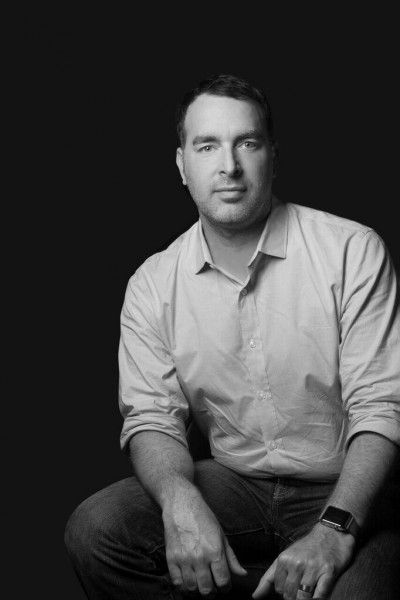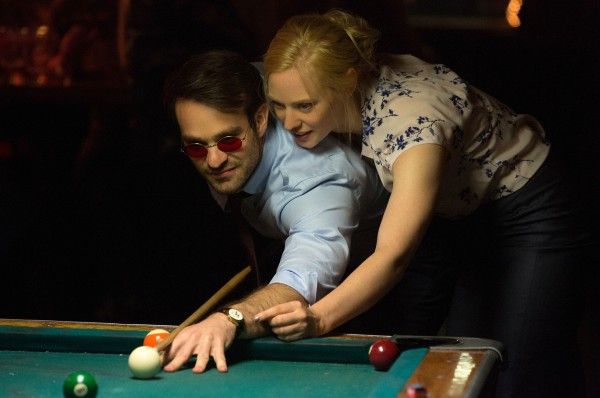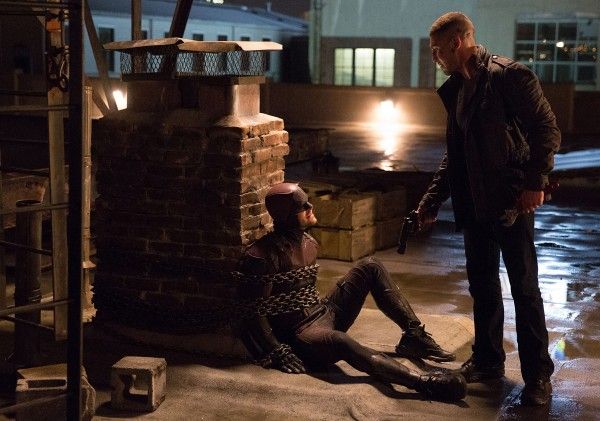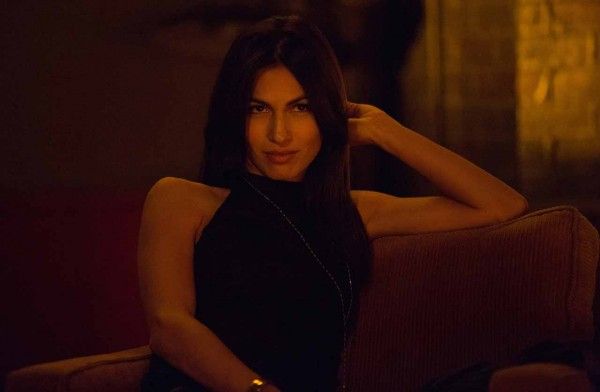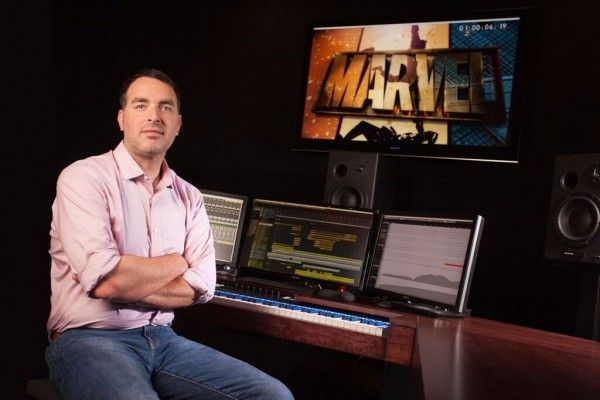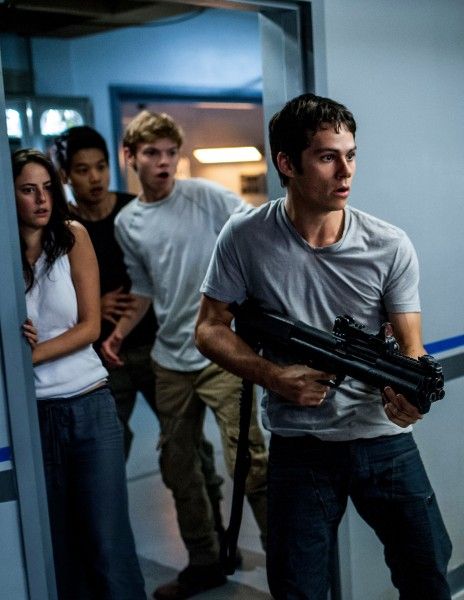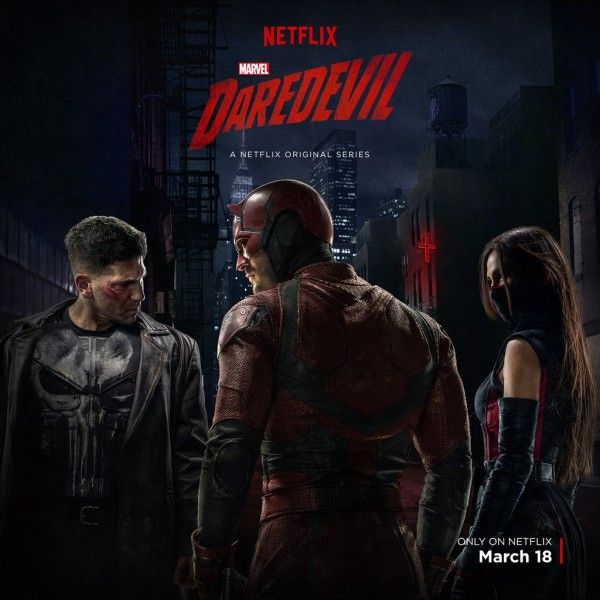To hear John Paesano tell it, if you don’t notice much of his latest score for Marvel’s Daredevil on your first excited binge of Season 2, that means he’s done his job. But the show’s composer, who’s been working nearly non-stop since his entrance into the field 15 years ago, has left a million and one fingerprints on the Netflix series, from the soon-to-be iconic theme to his carefully crafted “character themes” made just for Daredevil’s two most anticipated guests: The Punisher and Elektra.
Though the showrunners have changed (out is Steven DeKnight, and in are the dual minds of Doug Petrie and Marco Ramirez), the increasingly realized and frankly great second season of Daredevil continues to prove its place in the Marvel world while defining its own unique spot in superhero television. Along with the show’s newest crop of drama and intrigue is a new, punched up score from Paesano, featuring a quiet explosivity not unlike Murdock himself.
I had a chance to interview the composer, whose credits also include The Maze Runner trilogy (and a possible gig on Godzilla 2, but more on that later), ahead of the show’s season premiere on Netflix to talk about transitioning to Season 2 with different creative leaders, making way for the Punisher and Elektra, and the curious origin story of the show’s theme.
COLLIDER: So, I have a lot of questions about Season 2, but before we get into that, how’d you get involved in the project?
JOHN PAESANO: I had worked with Steven DeKnight on a project, and he was our showrunner for Season 1. I had worked on an initial project with Steven called Incursion, which was kind of like his pet project of his that he’d been working on and what he did was like a proof of concept and a little short to give some people a taste of what the show should kind of encompass. From that, we learned that we got together really well and we worked great together. A couple years later, I found out that he got chosen to take over the showrunning duties on Daredevil and I reached out to my agent and said, “Let’s get in touch with Steven.” I wanted to see if I could throw my hat in the ring to try to do that show. And so I touched based with Steven, and Steven said, “Totally.” As you can imagine, there was a lot of people interested in doing the show because of the content, it’s Marvel, blah blah blah, so I was fortunate enough to get my hat thrown in the ring. It came down actually to a demoing process for myself and a couple other composers, I was just lucky enough to come out on the show. That’s kind of the short version of how I got kind of involved.
And how did you and Steven kind of begin to create the sonic language for the show? It’s very distinct.
PAESANO: Once I was involved with the show, we had to move relatively quick because they were done shooting I think more than half of the episodes, and they had to get the show rolling right away. The bonus of having already worked with Steven earlier on in my career was great because I already had a good idea of his sensibilities, and we got along really well. That’s such a big part of film scoring that people don’t realize. There’s a portion of film scoring that’s writing the music, but a lot of it is how do you get along with the guy you’re working with, how do you interpret what he wants? It’s so subjective, you know? Your version of sad is probably different than my version of sad. It’s my job to figure out what your vision of sad looks like. There’s a whole translation process that goes into it, and Steven and I kind of, because we had worked with each other in the past, we had a kind of shorthand that allowed us to communicate and get to the point in a quick fashion and that was very beneficial because we were on such a quick schedule for Season 1.
So that being said, the approach that he initially wanted for Daredevil -- and it was the approach that we ended up taking, which was helpful -- was we really felt it was important to maintain a grounded feel for the character of Daredevil. A couple reasons being, Daredevil is such a different character for the Marvel Universe, he’s a much more grounded character. He’s very human, he’s got a handicap, he lives in New York City, he’s a lawyer, he’s got normal human friends, he’s not from another planet, blah blah blah. He kind of has got a darker, heavier, weightier background than some of the other characters per se. Taking that stuff into account, I think Steven thought it was an opportunity to play on that whole entire concept. He really wanted to give the… I don’t want to say “anti-Marvel feel,” but we wanted it to stand out and be different than what marvel had done.
With Avengers and Iron Man, they tend to be bright and shiny and clean and the music is very fantastical and energetic and it has a way different approach to it than the approach we took. The reason we made the decision we made was that we wanted to be sure that grounded feel was maintained and what that does is it kind of gives it an edge, gives the character a little more rawness to it and it was also important because a major part of the story is New York City, and one defining thing that we all agreed was so important and the one thing that defined it so well was the sound of the city. New York definitely has a certain energy to it and we really wanted to make sure the music was able to accentuate that and not get in the way of it and cover it. So we kind of had this super minimalistic approach and that was the trick of it. We wanted to be minimal but at the same time we definitely needed some epic qualities and we also needed energy to it as well so it was kind of a trick to figure out how to get all of those elements to dance and to play with each other. I think we kind of accomplished what we set out to do, so that was the initial introduction to Steven and the initial approach that we took in jumping into Daredevil.
So when Doug and Marco came in, how did that change things? Did you have to sort of retry everything?
PAESANO: Doug and Marco did such a good job of carrying the torch that Steven kind of handed to them, and they were a big part of Season 1, too, so it’s not like they were coming out of nowhere. They really were true to what we were trying to do in Season 1. There were just elements in Season 2 that we had to acknowledge. Obviously we have two characters being introduced, we have The Punisher and Elektra, and they both have their own backstories, their own interactions with Matt Murdock, so there are way more branches in this season than there were last season. Last season was an origin story dealing with Wilson Fisk, in this season there’s just a lot more going on, so from a musical perspective we just had to broaden the score to handle some of these different stories. As far as the theme though, we’re still using the same Matt Murdock theme, we’re keeping the main theme, all that stuff is still Daredevil. And even though there are these new stories, it’s still in the same Hell’s Kitchen atmosphere that we’re creating. So there’s definitely differences, but it’s not like we all of the sudden went into John Williams territory, you know? It’s definitely still dark, still gritty, it’s definitely a very grounded show but it definitely jumps up a couple levels.
In developing these new themes for Elektra and The Punisher, where did you start? Did you start from what you knew of them in the comics or did you kind of wait until you saw exactly what Elodie Yung and Jon Bernthal were doing with the roles?
PAESANO: I’m definitely familiar with the characters, and there are so many different ways you can tell these character’s stories. That’s why every time they put out a Marvel movie you can put out six movies about the Incredible Hulk, and every single one can be completely different even though it’s the same character. I never trust what I think it’s going to be until I actually see what someone’s interpretation of that character is and that’s certainly the case for Elektra. I had envisioned what Elektra would be like, I knew her from the comics and past franchises, I knew her from a lot of different sources but it seemed like I really needed to wait and see what Doug and Marco’s vision of Elektra was and Marvel’s vision for the show, what it was going to be before I could really iron down how I wanted to approach her character. Same holds true with Punisher, because they really are their own characters and centric to this series that’s being told by Marvel.
So I think it’s one of those things where until I had the footage up on my screen and I could actually put things against her and see what was and wasn’t working, I really took all those preconceived notions I had with a grain of salt and I thought this could be right or it might not be at all. That’s kind of how I went into her character and Punisher’s character. I mean, Punisher’s character is so good, there were moments where I didn’t even want to put music behind him, his performance. I could say the same thing with her too, there’s a lot of stuff going on with Punisher… I’m trying to say some stuff without giving too much away put it this way, each one of these characters, they aren’t cameo performances, they don’t show up for one episode and go away, they are deeply rooted into the story of Daredevil just as much as Matt Murdock is in this season and I think that’s one of the things fans are really going to appreciate about this season.
These themes also, I think, feel really important because so much of the score doesn’t really feel like a score in the way you’d traditionally think of it, it feels like tones or sounds almost.
PAESANO: We’re always trying to really ground it, and I use this term a thousand times, it’s a score I want people to feel and not necessarily hear. It’s definitely, again that comes back to what Steven and I initially set out to do in the very beginning of it. We wanted the show to feel as grounded and as raw as we could possibly get away with that would immerse people more in the story. When you’re watching a show like this or watching a movie, sometimes when you have big music in a scene, it tends to push the viewer out of the scene and makes someone feel like an audience member rather than like they’re in the scene. When you have music like in Daredevil that’s very subdued, in the background and felt and not really heard, it really allows people to partake. You feel like you’re standing there with Matt Murdock, you can feel the punches and you can hear the city roar in the background, you feel like you’re in the fight with Daredevil. That was kind of the goal, we really wanted people to feel like they were immersed in his world, we didn’t want people to feel like they were sitting on their couch watching a fight scene. So that was kind of a technique used to try to bring people into the fold of the action.
Is it true that the show’s theme as it exists now was actually derived from something you recorded during the demo process of your audition?
PAESANO: Yeah that’s actually true. The first scene that I demoed was the big hallway fight in Episode 2, Season 1, that like five-minute scene without a cut that actually became something a lot of fans really enjoyed. That was the first thing I ever wrote for Daredevil – it was the first footage I saw, and that’s where I came up with the theme. At the end of that scene, Daredevil walks into the room at the end of the hall, picks up the little boy, he walks down the hallway with him and the theme plays and it takes us to the act out. After conversations with Steven and the whole minimalistic, simplistic thing, when we were developing the theme for Daredevil, the one thing I wanted to make sure was that it was very, very simple so it was accessible to people. If you have a ton of counterpoints, complex harmony, all these tricky things going on, it makes things less accessible to people. I really wanted to make the theme definable and clear, so when it came time do the theme, I really took to heart my initial discussions with Steven and made sure that the theme we came up with for Murdock had a very simple structure to it and that obviously takes us to the title, where it’s the theme probably at one of its simplest forms, and it creates a really clean main title. So it’s one of those things with a simple melody and harmony, you can do so much with it because it’s very flexible, you can make it sad, you can make it happy, you can make it heroic, there’s a lot you can do with it.
Your work for The Maze Runner is almost the opposite, music is very, very present in that series.
PAESANO: When I sat down to do Maze Runner, because it was a trilogy, I always wanted to make sure that the score was going to be able to grow and mature along with the series. It’s like doing these episodic things, it just happened to be a film this time. I wanted to makes sure that I had a big picture idea in mind and how it was going to go through all the chapters we had to go through. It’s obviously a much more weighty, orchestral score than Daredevil is and that’s by design. Wes [Ball] and I wanted to border on the side of modern but with a wink to some of the older guard composers like a John Williams or a Jerry Goldsmith because they have so much character in their music. And Wes wanted it to be an actual character in the movie, he didn’t want it to just be background music, he wanted a little bit of a different thing than what we were trying to do with Daredevil. He doesn’t mind if it’s kind of right up there with the actors and performance, sometimes it was one of those things where we had a little bit more flexibility to push the envelope a little harder when it comes to where the music is going to live within the sonic space of the films.
So that being said, it kind of opened up the palette a little more too. Maze Runner is obviously not as grounded as Daredevil. There’s a lot of futuristic, dystopian kind of environments that the kids live in, you have a lot of reign to push the envelope a little bit more when it comes to size and scope of the story you’re trying to tell with the music, so all those different things really played a part in the creation of that soundtrack.
Both of these projects are sort of action-heavy, are you careful to sort of work out where you’re going to fall and where sound design is going to take over?
PAESANO: Well, yeah, I mean especially Daredevil, and Maze Runner as well, those are two projects that really demanded a good coordination between the sound department and the music department, and I kind of have to be in lockstep with those departments. And we just make sure that we are, sound is such an important aspect of that show because what I was saying about New York City. Doug and Marc are very conscious of that, they want to makes sure we maintain that definable aspect of New York so we have to be in lock step with our sound design. We spotted episodes together, we would have conversations about where we were going to hit what, we were definitely all on the same page and it really was a true collaboration between my department and sound design. Same thing with The Maze Runner series, Wes is very hands on with the music and sounds design, very hands on with those aspects of the film, making sure there’s room for him to experiment.
Can it be believed that you’re set to work on Godzilla 2?
PAESANO: No. I mean, there’s conversations, but nothing official.
IMDb is never great to take as gospel.
PAESANO: Yeah, I wouldn’t trust IMDb. I might be on a list with fifty other guys, one of those kinds of things. Next thing I’m doing is Death Cure, and no, Junkie XL is not co-scoring it with me, which it also says on IMDB.
That was my next question!
PAESANO: I’d love to collaborate with him one day, but…
We’ll get some IMDb editors out there and fix that right up.
PAESANO: I know it’s crazy isn’t it? It’s the Wikipedia of the movie industry.

